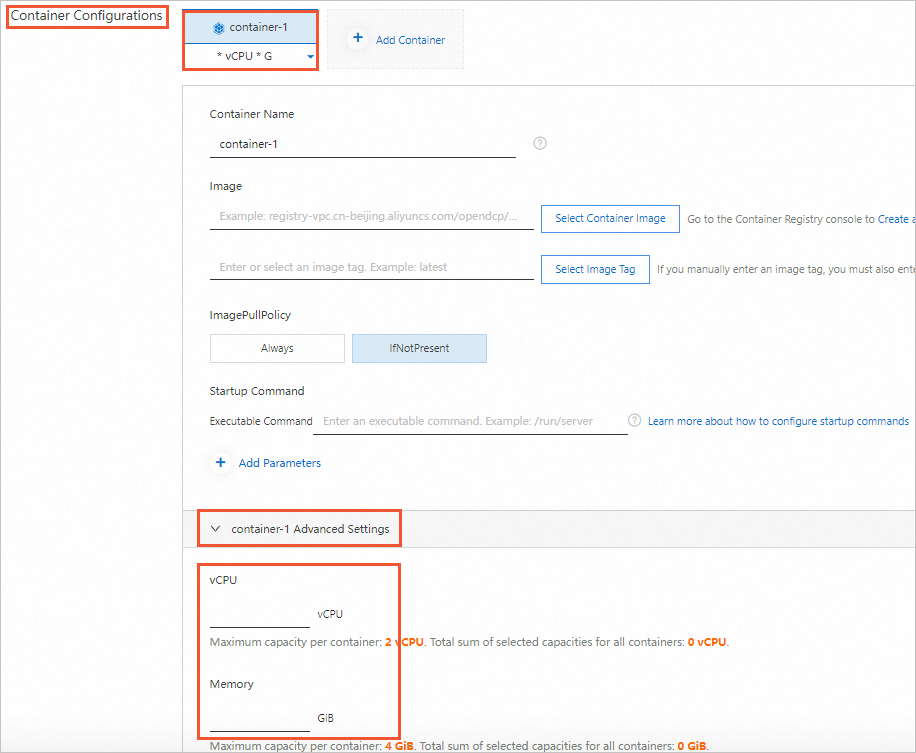GPUやローカルディスクなどの特別な仕様が不要な場合は、エラスティックコンテナインスタンスを作成する際に、Elastic Compute Service (ECS)インスタンスタイプではなく、vCPU数とメモリサイズを指定することをお勧めします。指定されたvCPUとメモリの仕様に一致する複数のECSインスタンスタイプがシステムによって試行されます。この方法では、単一のECSインスタンスタイプを指定する方法よりも、弾力性とリソースのプロビジョニングが向上します。
仕様の説明
エラスティックコンテナインスタンスを作成する際に、インスタンスまたはインスタンス内のコンテナのvCPU数とメモリサイズを指定できます。指定したvCPU数またはメモリサイズがElastic Container Instanceでサポートされていない場合、システムはElastic Container Instanceでサポートされている仕様に基づいて数またはサイズを調整します。システムが数またはサイズを調整する場合、システムはElastic Container Instanceでサポートされている最も類似した仕様を選択してインスタンスを作成し、システムによって選択された仕様は、インスタンスに指定した仕様以上になります。たとえば、中国(杭州)リージョンでエラスティックコンテナインスタンスを作成する際に7 vCPUと13 GiBのメモリを指定した場合、システムは8 vCPUと14 GiBのメモリを含むインスタンスを作成します。
次の表は、Elastic Container Instanceでサポートされている仕様を示しています。
vCPU数とメモリサイズを指定しない場合、システムはデフォルトで2 vCPUと4 GiBのメモリを使用してエラスティックコンテナインスタンスを作成します。
各エラスティックコンテナインスタンスには、1つのエラスティックネットワークインターフェース(ENI)のみをバインドできます。
すべての仕様のデフォルトの一時ストレージ容量は30 GiBです。
エラスティックコンテナインスタンス内のコンテナのvCPU数とメモリサイズを指定する
各エラスティックコンテナインスタンス内に最大20個のコンテナを作成し、各コンテナのvCPUとメモリの仕様を指定できます。各エラスティックコンテナインスタンスについて、すべてのコンテナのvCPUとメモリの合計仕様は、インスタンスのvCPUとメモリの仕様以下である必要があります。すべてのコンテナのvCPUまたはメモリの合計仕様がインスタンスのvCPUまたはメモリの仕様よりも高い場合、システムはコンテナの仕様を調整し、新しい仕様に基づいて課金されます。
Elastic Container Instanceでは、システムがリソースを調整する際にコンテナを無視するように、サイドカーコンテナなどの特定のコンテナの環境変数を設定できます。これにより、リソースの無駄を防ぎます。詳細については、システムがエラスティックコンテナインスタンスの仕様を調整する際に特定のコンテナを無視するを参照してください。
OpenAPI
CreateContainerGroup APIオペレーションを呼び出してエラスティックコンテナインスタンスを作成する際に、Container.N.CpuパラメータとContainer.N.Memoryパラメータを使用して、各コンテナのvCPU数とメモリサイズを指定できます。次の表に、これらのパラメータを示します。詳細については、CreateContainerGroupを参照してください。
パラメータ | タイプ | 例 | 説明 |
Container.N.Cpu | 数値 | 2 | コンテナNに割り当てるvCPUの数。Nはコンテナのシリアル番号を指定します。Nの最大値:20。 |
Container.N.Memory | 数値 | 4 | コンテナNに割り当てるメモリサイズ。単位:GiB。Nはコンテナのシリアル番号を指定します。Nの最大値:20。 |
コンソールモード
Elastic Container Instance コンソール (Elastic Container Instance コンソール) で弾性コンテナインスタンスを作成する際に、コンテナの詳細設定セクションで、各コンテナの vCPU 数とメモリサイズを構成できます。弾性コンテナインスタンス内のすべてのコンテナの vCPU の合計とメモリサイズの合計は、インスタンスの vCPU とメモリサイズ以下である必要があります。

エラスティックコンテナインスタンスのvCPU数とメモリサイズを指定する
この方法を使用すると、システムは指定されたvCPU数とメモリサイズに基づいてさまざまなECSインスタンスタイプを試行し、適切なECSインスタンスタイプを選択して、弾力性とリソースのプロビジョニングを向上させます。この方法には、次の利点があります。
エラスティックコンテナインスタンス内のコンテナのvCPU数、メモリサイズ、またはリソース制限を指定する必要はありません。これにより、コンテナは要求されたリソースをより柔軟に共有できます。
遺伝的計算とIstioのシナリオでは、サービスフレームワークはポッドにサイドカーコンテナを自動的にデプロイします。エラスティックコンテナインスタンスのvCPU数とメモリサイズを指定することで、Elastic Container Instanceをサービスフレームワークにシームレスに接続できます。
一部の仕様は、Elastic Container Instanceコンソールでは設定できません。コンソールでElastic Container Instanceでサポートされている仕様を選択できない場合は、APIモードを使用できます。
OpenAPI
CreateContainerGroup APIオペレーションを呼び出してエラスティックコンテナインスタンスを作成する際に、CpuパラメータとMemoryパラメータを使用して、エラスティックコンテナインスタンスのvCPU数とメモリサイズを指定できます。次の表に、これらのパラメータを示します。詳細については、CreateContainerGroupを参照してください。
パラメータ | タイプ | 例 | 説明 |
Cpu | 数値 | 2 | インスタンスに割り当てるvCPUの数。 |
Memory | 数値 | 4 | インスタンスに割り当てるメモリサイズ。単位:GiB。 |
コンソールモード
Elastic Container Instance コンソール (Elastic Container Instance コンソール) で弾性コンテナインスタンスを作成する際に、コンテナグループ構成 セクションの 基本モード タブで、弾性コンテナインスタンス (コンテナグループ) の vCPU 数とメモリサイズを選択できます。
